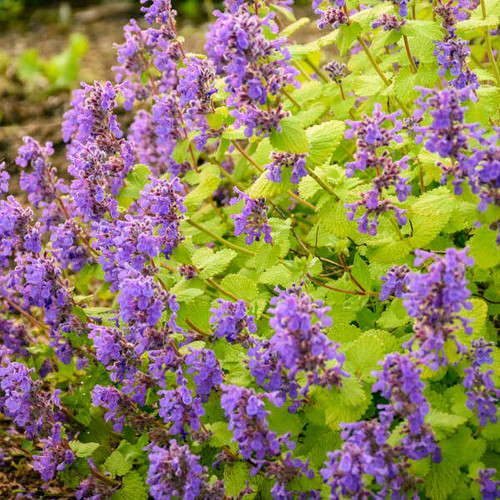Product Description
Nepeta 'Pike' PP18904 Little TrudyCommon Name: Catmint and Catnip
Zones 4 to 9.
Full sun.
Plants reach 10 to 12 inches tall and 12 to 18 inches wide.
Growth rate: Moderate, erect, dwarf herbaceous clump-forming perennial.
This dwarf catmint has distinctively short, compact, silvery green foliage and long bloom season. From early summer to fall, a profusion of lavender purple flower spikes are produced atop the finely textured mound of minty foliage. In bloom, this plant formed a low, wide, colorful mound.
Plant in average, well-drained soil. Shearing the plant back in the springtime will promote more compact growth. In addition, cutting plants back by half after their first bloom tends to stimulate a second bloom cycle.
Nepetas are one of the easiest perennials to grow as long as they are not given too much care and attention. They thrive on neglect. Too much water and/or fertilizer will engender thin floppy growth and a disappointing display. However place them in well drained, even poor soil, in full sun and these plants will reward with a magnificent display of flowers and fragrance.
Attributes: flower borders, containers, cut flowers and foliage, drought tolerant, fragrant mass plantings and easy to grow. Attracts butterflies, bees, hummingbirds. Deer and rabbit resistant.
Other Details
The most important part of the plant is its root system. Healthy roots are the foundation of a healthy, vibrant plant. The type of plug container used is based on the specific needs of the plants. Perennials offered as bare root traditionally perform better when planted as bare root.Planted in a specialized mix, potted plants have well established root systems. Top growth stage will vary depending on the current life cycle and time of year when shipped. In Winter and early Spring dormant plants may be shipped. Dormant plants may be planted right away, even before the last frost date.
Most bare root varieties are field grown for at least one season, though Hemerocallis and Hosta are grown for two seasons. The bulk of the soil is removed during the harvesting process and the tops of most varieties are trimmed back to the crown. They are graded, packed in shredded aspen or sphagnum moss and stored in freezers until ready to be shipped.
See our Container Sizes and Bare Root Perennials pages for more information.
Plant information and care is provided in the Overview section, Plant Genus Page and general information is provided in the Planting Care & Guides. Additional questions can be asked on each Plant page.
Plant Spacing: Using the maximum mature spread or width of a plant to guide spacing, ensures space to grow to full size. To fill an area sooner, plant them closer together. Just remember, future thinning or transplanting may be needed.
Water: Keep a close eye on newly planted perennials, especially throughout the first growing year. Most early plant loss is due to too much or too little water!








